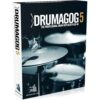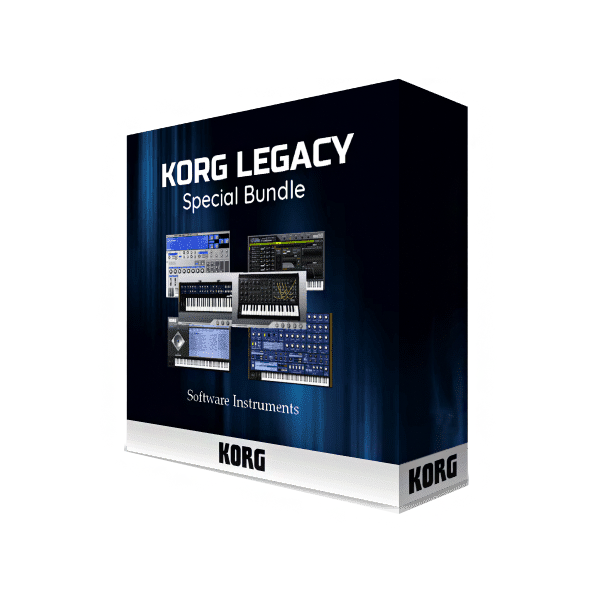- Empty cart.
- Continue Shopping
KORG Legacy Collection Special Bundle v01.2020
€199.00
The many great sounds that marked an era.
A synthesizer collection completely reconstructed in software.
Released in 2004, the KORG Legacy Collection was a pioneer of software synthesizers. Featuring a sound produced by authentic simulation of the analog and digital circuits of the legendary KORG synthesizers, the Legacy Collection has remained a best seller to this day.
Includes :
- MS-20 v1.2.4-R2R
- Polysix v1.4.2-R2R
- Mono/Poly v1.2.2-R2R
- M1 v1.8.2-R2R
- WAVESTATION v1.8.3-R2R
- MDE-X v1.4.3-R2R
- LegacyCell v1.4.3-R2R
KORG MS-20
MONOPHONIC SYNTHESIZER
The analog monophonic synthesizer with the potential for patching that went on sale in 1978: the MS-20. The entirety of the MS-20 is reproduced with its two oscillators (which can be ring-modulated), high-pass/low-pass self-oscillating filters with unique distortion, and a patch section with an external signal processor that can accommodate external audio input.
For the software, 32 voices of polyphony and up to 16-voice unison (with detune/spread function) were added. Flexible external modulation settings and MIDI clock synchronization have also been introduced, allowing for sound production with a high level of flexibility and freedom.
KORG Polysix
POLYPHONIC SYNTHESIZER
The programmable 6-voice polyphonic analog synthesizer released in 1981: Polysix. Everything from Polysix has been completely reproduced: the 1VCO (with sub-oscillator) /1VCF/1VCA/1EG configuration which enables a choice of SAW/PW/PWM waveforms, the chorus/phase/ensemble effects, and performance functions such as chord memory, arpeggiator, and unison.
The software enables versatile sound creation with enhancements such as 32-voice polyphony (max), up to 16-voice unison (with detune/ spread function), flexible external modulation settings, MIDI clock synchronization for the modulation generator and arpeggiator, and a spread function that adjusts the spaciousness of the effects.
KORG Mono/Poly
4VCO SYNTHESIZER
The four-VCO monophonic/polyphonic synthesizer that went on sale in 1981 and was considered the culmination of Korg’s experience building analog synthesizers: Mono/Poly.
All of the Mono/Poly’s multi-colored features have been completely reproduced: its programming structure featuring four VCOs, each providing adjustable pitch, waveform, octave, and level, together with one VCF, one VCA, two EGs, and two MGs; advanced Chord Memory and Arpeggiator functions; and the Synchro and Cross Modulation functions which can create revolutionary tonal effects.
The software adds many enhancements such as 128-voice polyphony (max) with up to 16-voice unison, two integrated multi-effects, an eight-way virtual patching matrix. The virtual patch functionality lets you use 159 different modulation sources to modulate 35 different destinations. This evolution of Mono/Poly allows for complex and diverse sound creation.
KORG M1
MUSIC WORKSTATION
The first workstation synthesizer, released in 1988, which defined the sound of the late ’80s and early ’90s: M1. Along with its innovative “workstation” concept, the M1’s “AI” (Advanced Integrated) synthesis system used PCM waveforms and digital effects to deliver fully complete program and combination sounds. As a pioneer of PCM tone generation, it was notable not just for the reality of its sound, but also for the distinctive resonance and tonal character that demonstrated the high level of Korg’s voicing technology. Numerous sounds available only from the M1, most notable the famous “M1 Piano” sound, were taken up by musicians and producers around the world, and are still in use today.
The software features filter resonance, VDA modulation, and master effects that have been powered up to a total of 18 systems. It provides all of the PCM, Program, and Combination data found in the original M1 and the M1EX internal PCM expansion, plus the PCM data and Program/Combination data from all nineteen optional ROM cards.What’s more, in addition to all 19 types of the PCM ROM cards for the M1, the sound of the M1EX which was released as an expansion of the M1’s built-in PCM, as well as the sounds of the T-series, which advanced the M1. It is equipped with extensive sounds, including 33,000 preset sounds and 34 cards.
KORG WAVESTATION
WAVE SEQUENCE SYNTHESIZER
The WAVESTATION synthesizer appeared in 1990 with its new “advanced vector synthesis system” which produced a new sound by combining and shifting between multiple complex waveforms.
The user could operate a joystick to “mix” or “morph” between four oscillators, or create a wave sequence by placing waveforms in a specific order to create rhythmic or melodic sequence patterns. In addition to these and other unique revolutionary features, the sound section has equipped all of WAVESTATION’s PCM, and the parameters of the delicate parts have been fully reproduced in the software by analyzing the circuit map of the original design.
The software provides extensive preset programs and waveforms found on all of the series’ models: WAVESTATION, WAVESTATION EX, WAVESTATION A/D, and WAVESTATION SR. 7 types of PCM and program cards are equipped. In addition to a total of over 1,500 built-in preset sounds, an enormous amount of added PCM waveforms and wave sequences allows for even more variegated sound production.
KORG MDE-X
MULTI EFFECTS PROCESSOR
MDE-X is equipped with 19 different effect programs carefully selected from KORG digital effects, including Compressor, Limiter, Overdrive, Equalizer (EQ), Talking Modulator, Flanger, Phaser, Chorus, Delay, and Reverb.
The plug-in uses an effect algorithm derived from the high-quality TRITON family of synthesizers. Now you can use these effects that have defined the sound used in so many tracks in the software. Also, with its 128 effect programs, MDE-X can be used in a wide range of applications such as sound design, live performance, and mixdown sessions.
MICROSOFT OFFICE 2019 HOME AND BUSINESS EDITION For WINDOWS 10 or MAC
€49.00Current price is: €49.00. Original price was: €249.00.Carte Cadeau Nintendo 15 EUR clé FRANCE
€19.99Current price is: €19.99. Original price was: €21.99.Sony MDR-ZX310AP
€99.00Current price is: €99.00. Original price was: €599.00.Shipping Details
- Please pay more attention to your order address which MUST MATCH your shipping address. (If you’re from Russia, Please leave your full name. It is very important)
- Items will be shipped within 3 business days after payment.
- Please check items when delivered, if damaged, please kindly accept it and contact us immediately. We will make a confirmation and resend you a new one.
| Shipping By | Shipping Cost | Estimated Delivery Time | Tracking Information |
| Thembay Express | Free Shipping | 12-20 days | Not available |
| LEX | $20.00 - $50.00 | 04-12 days | Available |
| Lorem Ex | $26.00 - $70.00 | 03-17 days | Available |
Packaging Details
- Unit Type: piece
- Package Size: 25cm x 32cm x 5cm (9.84in x 12.60in x 1.97in)
- Package Weight: 0.56kg (1.23lb.)



















Reviews
There are no reviews yet.